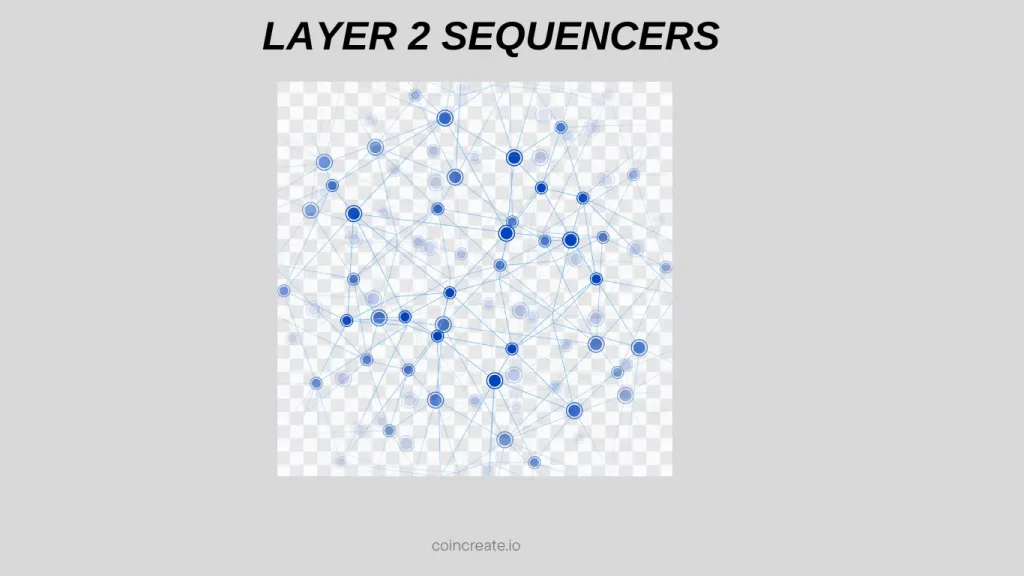What Are Layer 2 Sequencers?
As blockchain adoption grows, scalability remains a major challenge for networks like Ethereum. High transaction fees and slow processing times make it difficult for users to interact efficiently with decentralized applications (dApps). Layer 2 (L2) scaling solutions—such as rollups—help address this issue by processing transactions off-chain while still leveraging Ethereum’s security.

A key component of these solutions is the Layer 2 sequencer—a specialized mechanism responsible for ordering, batching, and submitting transactions to the Ethereum mainnet. By handling transaction execution off-chain, sequencers enable faster, cheaper transactions without compromising decentralization.
How Do They Work?
Layer 2 (L2) sequencers play a crucial role in scaling Ethereum by efficiently managing transaction ordering, batching, and submission to Layer 1 (L1). They serve as traffic controllers for rollup-based networks like Optimism, Arbitrum, and zkSync, ensuring faster, cheaper transactions while maintaining Ethereum’s security.
1. Receiving and Ordering Transactions
- Transaction Collection: Users submit transactions to the L2 network, where sequencers receive and temporarily store them in a transaction pool (mempool).
- Ordering Mechanism: Transactions are sorted using different priority models, including:
- First-Come, First-Served (FCFS): Ordered by submission time (e.g., Arbitrum).
- Gas Fee-Based Ordering: Prioritizes transactions offering higher gas fees.
- MEV Mitigation: Some advanced sequencers prevent Maximal Extractable Value (MEV) exploitation, ensuring fair ordering.
2. Batch Processing and Compression
- Batch Formation: Instead of sending individual transactions to Ethereum, sequencers bundle multiple transactions into batches to reduce costs and increase efficiency.
- Data Compression: Transactions are compressed using cryptographic techniques (e.g., Merkle trees) to lower gas fees.
- Pre-Execution: Some sequencers simulate transactions before submission to ensure they meet gas limits and execution constraints.
3. Submitting Transactions to Layer 1 (Ethereum)
- Once a batch is ready, the sequencer submits it to Ethereum’s mainnet via smart contracts like sequenceBatches().
- The batch submission includes:
- Transaction data (compressed form).
- Timestamp of when the batch was created.
- Sequencer’s address (to track fees).
- Cryptographic proof (Merkle root) ensuring data integrity.
- After submission, transactions become final and secure on Ethereum.
4. Security and Finalization
To ensure trust and correctness, different rollups use:
- Fraud Proofs: Transactions are assumed valid unless challenged.
- Validity Proofs: Cryptographic proofs ensure correctness before submission.
Once finalized on Ethereum, L2 users gain full security benefits of L1.
5. Efficiency Optimizations
Modern sequencers enhance performance by:
- Fast execution engines to process transactions instantly.
- Reducing database writes to minimize delays.
- Optimizing gas usage to lower costs further.
Types of Layer 2 Sequencers - Centralized vs. Decentralized
Layer 2 (L2) sequencers play a critical role in scaling blockchain networks by organizing, processing, and submitting transactions to Layer 1 (L1). They can be classified into three main types: centralized, decentralized, and shared. Here’s how each works and their key differences.
1. Centralized Sequencers
Operated by a single entity, typically the core development team of the L2 protocol.
Examples: Arbitrum, Optimism, Base
How They Work:
- A single node orders and batches transactions.
- Transactions are finalized instantly on L2 before submission to Ethereum L1.
Advantages:
- ✔️ High speed & low latency due to direct control.
- ✔️ Simpler architecture for easy deployment and maintenance.
Disadvantages:
- ❌ Risk of centralization (censorship, single point of failure).
- ❌ Vulnerable to downtime if the sequencer goes offline.
2. Decentralized Sequencers
Transactions are handled by a network of nodes, ensuring no single point of control.
Examples: Metis (peer-to-peer validator network)
How They Work:
- Transactions are processed by multiple nodes, either randomly selected or rotated.
- Batched transactions are submitted collectively to Ethereum L1 for validation.
Advantages:
- ✔️ Increased security & censorship resistance due to decentralization.
- ✔️ Resilient against failures, as control is distributed.
Disadvantages:
- ❌ Slightly slower than centralized systems due to coordination overhead.
3. Shared Sequencers
Serve multiple L2 rollups simultaneously, acting as a sequencer-as-a-service.
Examples: Espresso Systems, Astria
How They Work:
- A shared sequencer network processes transactions for multiple rollups.
- Facilitates cross-rollup communication and standardizes sequencing.
Advantages:
- ✔️ Enhances interoperability between different L2s.
- ✔️ Reduces costs by sharing infrastructure.
Disadvantages:
- ❌ Scalability challenges when processing large transaction volumes.
Comparison Table: Key Differences
| Feature | Centralized Sequencers | Decentralized Sequencers | Shared Sequencers |
|---|---|---|---|
| Control | Single entity | Distributed network | Shared across rollups |
| Performance | High | Moderate | Moderate |
| Security | Prone to censorship | Highly resistant | Resistant |
| Interoperability | Limited | Limited | High |
| Examples | Arbitrum, Optimism, Base | Metis | Espresso Systems, Astria |
Pros and Cons of Layer 2 Sequencers
Layer 2 (L2) sequencers are essential for scaling Ethereum and other blockchains, enabling faster transactions and lower costs. However, they come with trade-offs in decentralization and security. Below is a detailed breakdown of their benefits and drawbacks.
Pros of Layer 2 Sequencers
- Improved Scalability: Transactions are processed off-chain, reducing congestion on Ethereum Layer 1 (L1). Enables high throughput, making L2 networks ideal for handling large transaction volumes.
- Lower Costs: Batch processing significantly reduces gas fees compared to direct L1 transactions.
- Enhanced User Experience: Transactions are approved almost instantly on L2, providing faster finality and a smoother experience.
- Security Integration: Fraud proofs and validity proofs ensure L2 transactions inherit Ethereum’s robust security framework.
- Revenue Generation: Centralized sequencers generate transaction fee revenue, supporting protocol development.
Cons of Layer 2 Sequencers
- Centralization Risks: Many L2s use centralized sequencers, leading to potential censorship, single points of failure, and reduced decentralization. Example: Arbitrum experienced downtime due to an overloaded sequencer during high activity periods.
- Censorship Concerns: Centralized sequencers can exclude or blacklist transactions due to regulations or malicious intent.
- MEV Exploitation: Sequencers can manipulate transaction ordering to prioritize profits over fairness.
- Limited Decentralization: Unlike L1 validators, centralized sequencers lack decentralization, reducing trustlessness.
- Scalability Challenges in Decentralized Models: Decentralized sequencers face coordination overheads, leading to slower performance compared to centralized systems.
Key Trade-Offs: Centralized vs. Decentralized Sequencers
| Feature | Centralized Sequencers | Decentralized Sequencers |
|---|---|---|
| Performance | High | Moderate |
| Censorship Resistance | Limited | High |
| Security Risks | Single point of failure | Distributed control |
| Cost Efficiency | Low operational costs | Higher coordination costs |
| Decentralization | Minimal | Strong |
Case Studies Arbitrum, Optimism, and Base Sequencing Models
Layer 2 (L2) networks like Arbitrum, Optimism, and Base rely on sequencers to manage transaction ordering and submission to Ethereum Layer 1 (L1). While their architectures share similarities, their approaches to decentralization, efficiency, and security differ. Below is a breakdown of their sequencing models, challenges, and future developments.
Arbitrum’s Sequencer Model
Current Design:
- Operated by Offchain Labs, Arbitrum’s sequencer is centralized and follows a first-come-first-serve (FCFS) ordering model to ensure fairness.
- Transactions are batched off-chain before submission to Ethereum via an inbox contract.
Key Features:
Fast finality – Users receive instant confirmations before final L1 settlement.
Efficient batching – Reduces gas fees for users.
Challenges:
Centralization Risks: A single-point failure can cause censorship and downtime. Example: During high traffic periods, Arbitrum’s sequencer faced congestion-induced outages, delaying transactions and raising fees.
MEV Exploitation Risks: Centralized control allows potential manipulation of transaction ordering for profit.
Future Plans:
Arbitrum is working on decentralizing its sequencer through:
- Collaboration with Espresso Systems for decentralized preconfirmations.
- Multi-slot selection research to distribute sequencing power among multiple participants.
Optimism’s Sequencer Model
Current Design:
- Operated by Optimism’s core team, the sequencer is centralized, prioritizing transaction speed and fee efficiency.
- Uses fraud proofs for finalizing transactions on Ethereum L1.
Key Features:
Optimized for cost-efficiency – Minimal complexity reduces operational costs.
Fast processing – Prioritizes transaction efficiency over complex ordering mechanisms.
Challenges:
Centralization Trade-Offs:
- A single sequencer exposes Optimism to censorship risks and downtime vulnerabilities.
- Past sequencer failures have delayed user transactions.
Scalability Concerns:
- As usage grows, a centralized sequencer may struggle to handle increased transaction volumes, requiring additional optimization.
Future Plans:
Optimism has committed to progressive decentralization as part of its OP Stack roadmap, aiming to:
- Introduce decentralized sequencing participants.
- Enhance censorship resistance through multi-party validation.
Base’s Sequencer Model (Coinbase)
Current Design:
- Developed by Coinbase, Base operates a centralized sequencer closely integrated into Coinbase’s wallets and exchange ecosystem.
Key Features:
✔ Seamless Coinbase integration – Optimized for onboarding new users from Coinbase’s platform.
✔ Leverages Ethereum’s security – Uses rollup technology for reduced transaction fees.
Challenges:
Over-Reliance on Coinbase:
- Base’s infrastructure is heavily tied to Coinbase, making it less neutral than other L2s.
- Regulatory actions or Coinbase outages could directly impact Base’s transaction processing.
No Clear Decentralization Plans:
- Unlike Arbitrum and Optimism, Base has not yet outlined a roadmap for a decentralized sequencer.
Comparison of Sequencing Models
| Feature | Arbitrum | Optimism | Base (Coinbase) |
|---|---|---|---|
| Sequencer Type | Centralized (plans for decentralization) | Centralized (future decentralization) | Centralized |
| Transaction Ordering | FCFS (Fairness-focused) | Efficiency-optimized | Integrated with Coinbase |
| Censorship Resistance | Limited | Limited | Limited |
| Decentralization Plans | Active research & proposals | Roadmap commitment | No clear plans |
| Challenges | Outages, MEV risks | Scalability pressure | Dependence on Coinbase |
Conclusion & The Future of Layer 2 Sequencers
Layer 2 sequencers are essential for Ethereum’s scalability, enabling faster transactions, lower fees, and higher throughput. However, the current reliance on centralized sequencers introduces risks such as censorship, fragility, and reduced decentralization. The future lies in decentralized, modular, and shared sequencing solutions that enhance security and interoperability while maintaining performance.
Key Developments in Layer 2 Sequencers
1. The Push for Decentralization
Decentralized sequencers distribute transaction ordering across multiple nodes, reducing single points of failure and improving censorship resistance.
Projects like Metis and zkSync are actively exploring decentralized models to strengthen network resilience.
2. Shared Sequencer Networks
Espresso Systems is pioneering shared sequencing solutions, allowing multiple rollups to utilize a common sequencer network.
Shared sequencing enhances cross-rollup interoperability and reduces operational costs while maintaining transaction efficiency.
3. Integration with Ethereum Validators
- A promising direction involves Ethereum validators handling Layer 2 sequencing duties, ensuring deeper integration with Layer 1 while decentralizing transaction ordering.
- This approach could leverage Ethereum’s existing validator set to improve security and reduce reliance on centralized entities.
4. Technological Upgrades
- The Dencun upgrade (EIP-4844) will introduce proto-danksharding, significantly reducing Layer 2 transaction fees and making decentralized sequencing more practical.
- Modular blockchain designs will allow rollups to integrate decentralized sequencing from inception, avoiding retrofitting challenges.
Espresso Systems’ Role in Decentralized Sequencing
Espresso Systems is at the forefront of decentralizing Layer 2 sequencing, addressing the limitations of current centralized models through:
Decentralized Block Production: Espresso’s shared sequencer network enables distributed transaction ordering across multiple rollups, reducing centralization risks.
Seamless Interoperability: By enabling atomic cross-rollup communication, Espresso improves interoperability between different Layer 2 solutions, overcoming siloed ecosystems.
Cost-Efficiency: Shared sequencing reduces the operational costs for rollups, making decentralized sequencing more accessible for new Layer 2 projects.
Challenges & Adoption Barriers
Despite the advancements, several hurdles remain:
Implementation Complexity: Moving from centralized to decentralized sequencing requires overcoming technical challenges like network latency and coordination overhead.
Performance Trade-offs: Decentralized sequencing must balance security with transaction speed and efficiency, especially in high-demand scenarios.
Adoption Barriers: Many developers and users lack awareness of centralized risks, slowing down adoption of decentralized solutions.
Final Outlook
The future of Layer 2 sequencers is shifting toward decentralization as shared networks like Espresso Systems drive innovation. Upgrades like EIP-4844 will further improve efficiency and reduce costs, making decentralized sequencing more viable. While challenges remain, the industry’s momentum suggests a shift toward scalable, interoperable, and decentralized Layer 2 ecosystems in the coming years.

